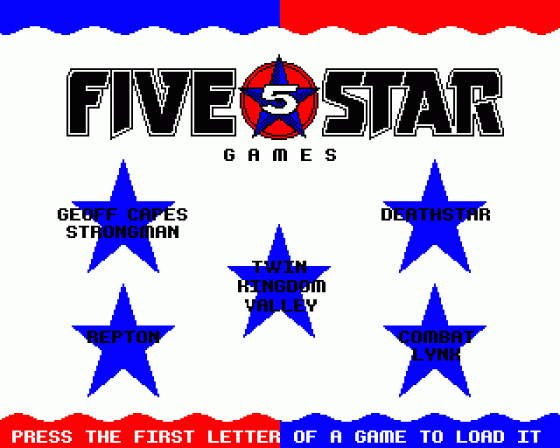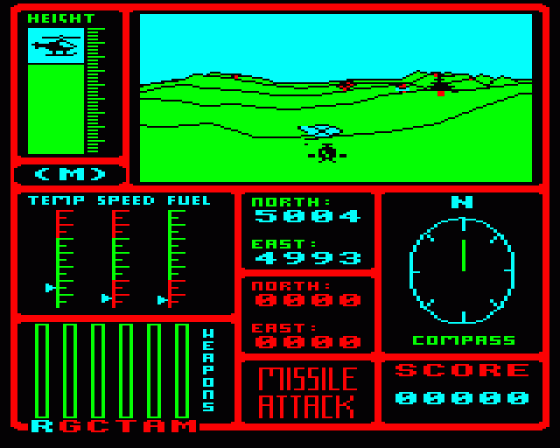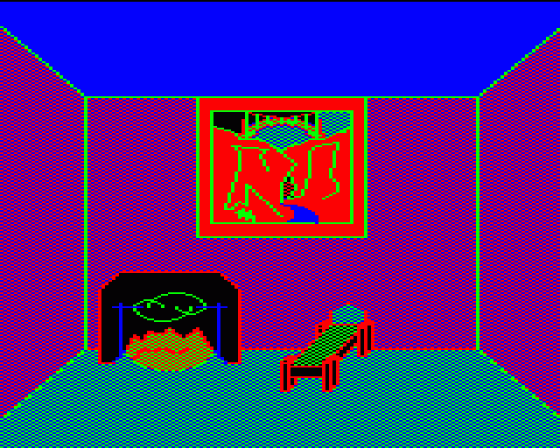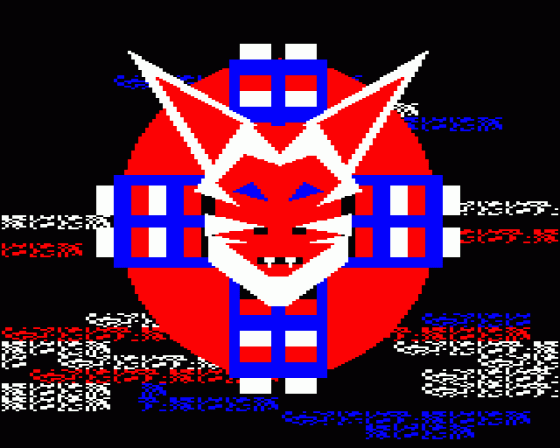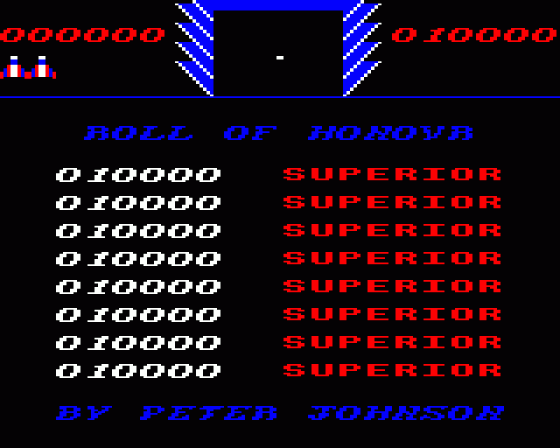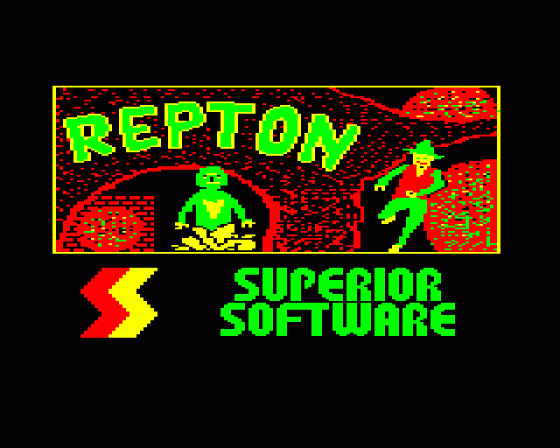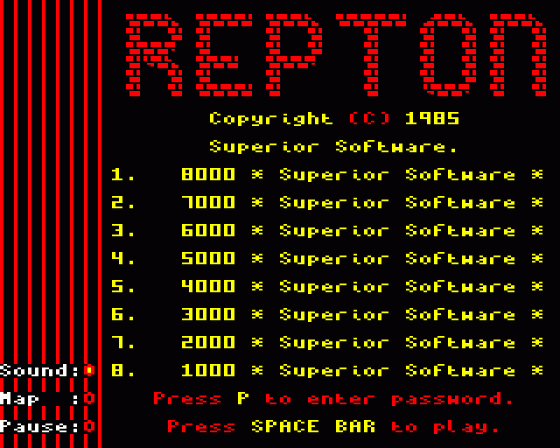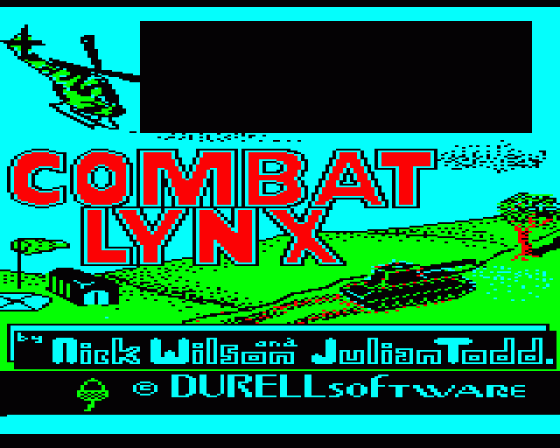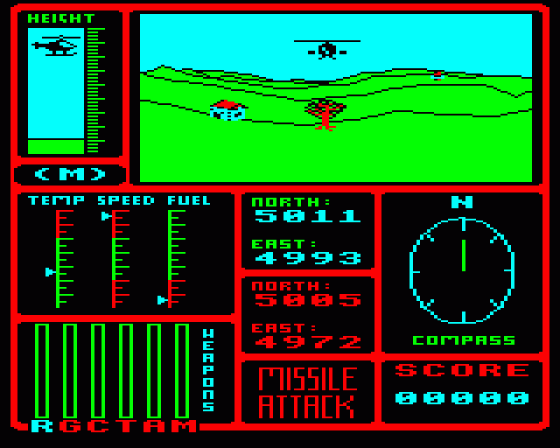
EUG PD
 1st January 2007
1st January 2007
Categories: Review: Software
Author: Dave E
Publisher: Beau Jolly
Machine: Acorn Electron
Published in EUG #67
Five Star Games
When games are brought together on a compilation, they offer you a chance to re-explore them. Particularly now many Electron compilations are available on disc, I often find myself having 'a quick go' on a hitherto unplayed game, just because it happens to be on the same disc. Five Star Games is one of the latest compilations to be 'discified', although the individual games which comprise it have been available individually for some time.
Five games are included in the compilation: Geoff Capes Strongman, Death Star, Twin Kingdom Valley, Repton and Combat Lynx. The disc boots up with a menu rendered in much the same way as the original packaging for the cassette release; the first letter of each game loads that game into memory. Because of the colours chosen for the palette on this screen, the titles are just a bit difficult to read (written in black on a dark blue background) but other than that it's a pleasing start.
The games themselves are all machine code and, in 1983-1985 at least, all retailed around the £9.95 mark. That's not to say however that they are all worth it. I have some qualms with the packaging for the original cassette version of this release, by Beau Jolly, to begin with. The back inlay presents a description of each of the games included with a 'Beau Jolly Rating', without exception awarding five stars or a very high percentage mark, to each of the games. The more shrewd of us might be rather dubious of reviews by the very software house selling the product! Beyond question there are some crackers in there: Death Star and Repton probably need no introduction to many. But the first game, Geoff Capes, is nowhere near in the same league.
Geoff Capes Strongman
You are Geoff Capes, situate in a TV studio where you are attempting to put those muscles to good use by performing a series of crowd-pleasing tasks such as rolling a car onto its roof, sumo wrestling and log chopping, amongst others. This is probably one of the two games in the compilation which requires detailed consideration of the instructions. There are no clues about how to progress on-screen: not even a 'Press SPACE/Fire to continue' message and, when each game starts, you can either start 'key-hammering' or just press RETURN to begin. Whether you choose one or another vastly alters how the game develops.
The keys are the standard ZX*? and RETURN to move. There are six events to complete, and before each one there is a 'training session', in which you attempt to pump up the jam, sorry the muscles, in anticipation. If you choose to start by 'key-hammering', you have to repeatedly press keys Z and X as fast as you can to try and build up an 'energy bar' on the right hand side of the screen. The other option, simply pressing RETURN, gives you a random amount of 'energy bar'. To me, this system gives the game a very bad start.
Firstly, it seems impossible, without smashing on the keyboard so hard as to break it, to get anything more than about 30% of the 'energy bar' if you choose key-hammering. Considering you get a minimum of 40% of you choose the random option then, in practice, you will always choose to just press RETURN - unless you are some sort of masochist who enjoys spending your money on a brand new Electron each week! We then move on to the allocation of the 'energy bar' which varies wildly. Sometimes you'll start with 90% energy, sometimes with 40%. As you do not have the same randomness factor in building up energy during the events, it seems that you start many games severely disabled, through no fault of your own!
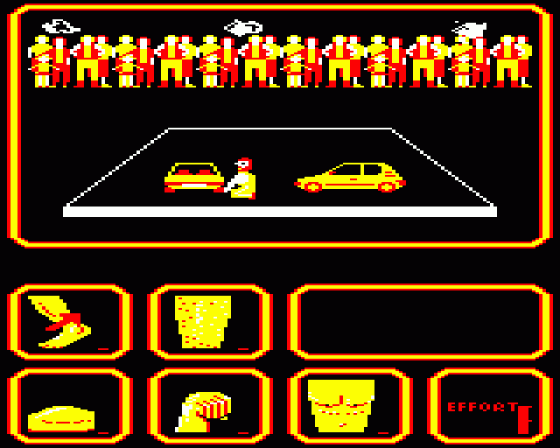
You now have to distribute your 'energy bar' to each of your (Geoff's) muscles, by moving an arrow around five different icons, including hands, chest, arms, ankles and legs. You almost always end up distributing the energy equally. Again this seems like time that is simply wasted in preparation for the game itself.
The instructions given by Beau Jolly list the events in the wrong order, so you start the game expecting to play tug of war and in fact get a car to roll over. This would not be too bad in itself, as it is a simple matter to skip forward to the correct section, but for a game where frequent reference to the instructions is necessary, you do start to wonder just how the publishers could have gotten this wrong.
To roll the car requires you to watch the muscle icons carefully, wait until you see one of them flash, then move the arrow to that muscle and press RETURN. The response to your keypresses is sluggish, and the arrow frequently goes one box too far, or does not move at all. There's also the added complication of a time limit which is extremely strict even on the lowest skill level. For example, to roll over the car in event one quickly, you need to increase the 'effort' you are putting into the event. This requires use of the cursor up and down keys, hence you are trying to navigate two sets of controls - up and down cursor keys plus ZX*?RETURN all at the same time. When you do manage to position the arrow correctly, you have to listen very carefully after you press RETURN to hear the blip that tells you the key has registered and Geoff is now utilising that muscle.
Therefore, to play without sound is impossible. One wonders why, therefore, the game starts by asking you whether you want 'Sound (Y/N)?'!
There are several other problems. You must press the RETURN key on a flashing icon only once, even though it remains flashing, else you will be needlessly diminishing the strength of that muscle. This is not pointed out in the instructions. If you increase your effort too much, then all the icons start flashing ridiculously fast and, because of the slow reaction of the arrow to your commands, they are impossible to keep up with. And finally, the game includes some good graphics, towards the top of the screen, with Geoff rolling cars, angling a hammer and wrestling with fellow strongmen, but you have to concentrate so hard on the icons that you cannot enjoy any of them.
Death Star
You can see that, as far as faults with this first game goes, it's more or less a question of 'How long have you got?' so happily I now move on to one of the most supremely playable games ever released for the Electron: Death Star. This is an almost pixelwise and playabilitywise clone of the arcade game machine Sinistar and, where Geoff Capes looks very dated by modern standards, this looks set to remain very handsome and almost infinitely playable until the end of time. Yes, Death Star really is that good!
You are a small spaceship somewhere in the cosmos - you can whirl left and right with the Z and X keys and fire an infinite stream of bullets with RETURN. Also present in the cosmos with you are rather large blue planetoids, red Worker bugs and blue (and pink) Warrior shooting thingymebobs. Your aim is to survive for as long as possible and to outwit 'the Daddy' of the cosmos, one of the famous Big Bosses of the 1980's, the Death Star ship.
When you start the game, he doesn't exist. He is in fact, built, by the Workers, as the tournament (and it is a tournament) commences. It works like this: the blue planetoids have, concealed inside them, a number of glowing crystals. A stream of bullets directed at a planetoid will dislodge the crystals and send them hurtling through space. You can grab them, or the Worker bugs can grab them. Crystals you grab turn into starbombs, which can ultimately be used to tackle the Death Star. Crystals the Workers grab are scurried away deep into the cosmos and manufactured into the Death Star ship. Twenty crystals transported to his lair by his minions and he will be 'completed' - and immediately chase your ass.
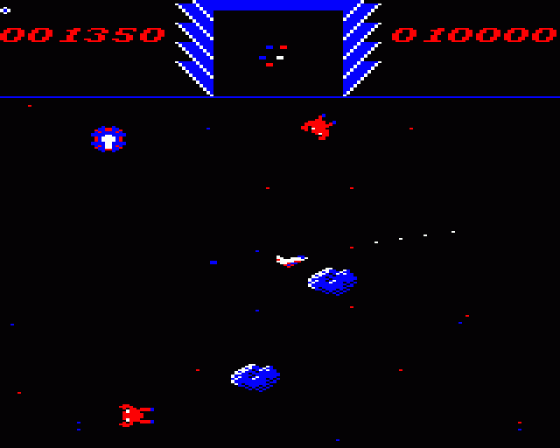
The concept works because it combines three classic battles in one: simultaneously it is man against machine; David against Goliath, and Frankenstein against the Monster. The Death Star is a formidable opponent - it travels twice as quickly as your ship, it can toyko drift from side to side to avoid your starbombs and a touch from one of its pixels and you will be sucked into its centre for a very quick and splendid demise. However, your skill at reading the radar, anticipating its arrival, releasing starbombs appropriately and altering your course ultimately mean outwitting it is achievable. Finally, it is created from the crystals you choose to let get away. If a Worker grabs a crystal, you don't have to give up, you can trail the Worker, blast it out of the sky and collect the same crystal again. But ultimately you will strike a balance, collecting the crystals that you need and letting a comparative number of crystals go, because the Death Star needs to be manufactured and destroyed in order for you to complete the level.
Death Star is a furiously fast number, with a radar screen at the top of the screen and a large playing window situated beneath. Your ship can be spun at almost any angle seamlessly and without too much risk. You are not killed by any collisions with planetoids or Workers or the only other baddy, the Warriors. The Warriors however, are best given a wide berth as they can shoot, and their bullets will destroy you on contact.
What is particularly pleasing about the Death Star itself is that, when it does attack, the damage your starbombs cause to it can actually be seen on screen. Each hit is accompanied by an explosion that wipes out an area of the ship. Eventually you are left with nothing except a small cabin on which is painted the Death Star's mouth giving chase. If you take it out then is a fanfare and 'DEATHSTAR DESTROYED' flashes all over the screen, giving an immense feeling of satisfaction before you get to do it all over again. The games continues until either you run out of lives or get bored with it.
Twin Kingdom Valley
Twin Kingdom Valley is the Electron conversion of a Commodore 64 version, just recently (2006!) back on scene in a big way with conversions for mobile phones and the PC making the headlines on the 8-bit web sites. It is a text adventure with around 100 illustrated locations [Many of which can be seen in our illustrated walkthrough - Ed] and one of the best-known and best-loved text adventures of all time.
The scenario, displayed on screen as the game loads, speaks of the Forest King and the Desert King, the two arch-enemies of the title, although, peculiarly enough, doesn't instruct you regarding which of them you support. However, I can tell you that you are on the side of the Forest King (Because killing him results in instant death) and that you should aim to kill the Desert King (Because killing him boosts your score). I would prefer to have had some explanation as to why the Desert King, as opposed to the Forest one, is such bad news that he warrants grisly execution. However, I was able to weigh up the Forest King's gift of a silver key and the Desert King's lunge with a knife to divide the good from the bad in the end.
The game was roundly berated by all 'serious' adventurers when it was first released, due to numerous bugs which (a) did not allow you to achieve the maximum score, (b) mean that creatures sometimes attack before it is possible to defend yourself, (c) having a needlessly difficult SAVE/LOAD routine, and (d) having a completely illogical map. These are all very valid criticisms and very apparent when you play the game. Most adventurers are logical thinkers, and try to map each area they traverse so that they can find it again easily later in the game. Twin Kingdom Valley however, is one of those games where going EAST from location 1 can take you to location 12, where going WEST takes you to location 5, making map-making an extremely tortious affair. However, that is not to say it cannot be done, and Electron User did manage, in the end to publish such maps.
If creatures attack before you are very far into the game, and follow you if you run away, constantly smacking you around the head with an axe then, of course, this is incredibly frustrating. There are also elements of the traditional adventure, i.e. collect treasures and return them to one place, which Twin Kingdom Valley seems to adhere to, but which ultimately do not allow you to achieve the maximum score and leave the player flummoxed.
Despite all of this though, the game's lush visuals give it an almost enigmatic appeal. Many people who do not like text adventures, who find them boring and difficult to follow, loved, and will love, Twin Kingdom Valley. It is also a simply remarkable piece of coding, managing to squeeze hundreds of illustrations and location descriptions into a mere 28K of code. Plus, if you want to play it as a 'traditional' adventure, it allows you to turn off the illustrations and do so.
Repton
On then, to Repton, and once again it's difficult to put into words what a perfect little arcade puzzler you've got here. One of the most famous characters of all time on the BBC and Electron, Repton spawned no less than six professional sequels and hundreds of user-defined PD characters and screens. This is Repton's very first outing, only featuring twelve screens, and with more limited features than the "REPTON 3 SERIES" which eventually evolved from it, but a perfect introduction to the world of rocks, reptiles and diamonds.
For those of you who have been in hibernation for the past twenty years, Repton is an overhead maze game. You are a green reptillian type of creature (who for some reason wears a shirt and trousers) and the maze contains a set amount of diamonds to collect. You must collect every last one to complete the level. The situation is complicated, however, by the existence of rocks, and eggs from which reptiles emerge. Both of these will fall if unsupported, and you don't want to get in the way of a falling rock, or a rabid reptile. The game has a peculiar type of gravity, in that, if you really think about it, your character, and reptiles, can 'float' but rocks fall according to the laws of physics. However, that is here nor there because the concept is second nature to understand.
You must ensure that falling rocks don't trap diamonds or hit you - but do kill the reptiles! - that you collect the key on each level and that you collect all the diamonds before the time runs out. The key, when collected, opens the last elements of the game - the safes, which contain one diamond each.
There is little sound to speak of, apart from a spritely little loading tune, a ping when a diamond is collected and the sound of falling rocks as, and when, required. The graphics are gorgeous with all information regarding the maze on screen, and your character has four lives. Some mazes can be completed in more than one way, some mazes cannot - forcing you to play many of them at least twice in order to figure out your route and then again to confirm it. A password system allows you to start on any screen.
It's hard to underappreciate this game when you are aware of all that followed but even now I cannot find any flaws in it.
Combat Lynx
Finally, we have Durell's Combat Lynx, labelled as an 'air-to-ground battle simulation' and 'the most comprehensive battle simulation ever written for a home computer'. Certainly these are impressive claims and, on loading, there are some revolutionary machine code loaders and fading systems for the time. The game is also written in 100% machine code, and is a full-screen Mode 5 affair with rolling hills featuring farm-houses, trees, and overground bases. All appear with a 3D effect and are multi-coloured, raising the playing experience much higher than for example the Hewson train simulation games.
This is the second game in Five Star Games where playing is not, in any way, intuitive. The instructions inform you that you can play the game as a straightforward shoot-'em-up, or a fully-fledged man vs. machine war game. Unfortunately, before I could decide on either, I had to get to grips with the keys and this, I'm afraid, is Combat Lynx's downfall.
The game begins with your helicopter positioned on a base, and the 1/3rd screen size display area is situated to the top-right whilst the rest of the screen displays a bewildering cockpit display. You are under attack from enemy forces as soon as the game commences with 'MISSILE ATTACK' immediately flashing red. The missiles do not move very quickly and are not heat-seeking, so rising from the base and flying left or right should be enough to ditch them. However, the keys are incredibly confusing, with the traditional ZX*? combination replaced by Z/X>. It is not exaggerating to say that with any other arcade game for the Electron, you have your left hand controlling up/down or left/right, and your right hand doing the opposite. Whereas with Combat Lynx, it is almost as if you have reprogrammed your keyboard - and your brain needs reprogramming along with it. Your left hand is responsible for going left and going down, with the two keys that are usually used for left and right. Your right hand is responsible for going right and going up, with the key usually responsible for down being right. To complicate matters even further, C slows you down, and < speeds you up. Right next to all of these keys on the right is the M key, which transports you to an intelligence map.
Unfortunately, after a good half an hour trying to fly the helicopter, I was still veering into the ground and spinning to the right instead of landing, whilst being under attack the whole time from tanks and incoming missiles. I succeeded in equipping my helicopter with one weapon and taking out one airplane but even this felt laboured. Concentrating on the keys to press leaves little room for concentrating on the objective: the target sights are also moved with the bewildering key combination.
The scrolling scenario is indeed beautiful and on an Electron it is undoubtedly the result of some incredibly complex and clever programming. One suspects that what the programmers have done is to try and mimic, in the keyboard layout, the layout of an actual helicopter. Which may be fine for helicopter pilots, but not for us arcade players. On top of this, I have to confess that I don't like wargames all that much, so the combination soon had me reaching for the BREAK key.
Verdict
My verdict on Five Star Games is a resounding thumbs-up. At least graphically, all the games are worth checking out. Geoff Capes and Combat Lynx have, for me, limited playability. This is because they have flaws which go to their very heart, and, even though they were once full-priced games, they do little more than parasite off the true classics. What struck me most in compiling this review was that Five Star Games was one of the first compilations I was given for Christmas. I was about ten years old at the time, and I played Death Star, Twin Kingdom Valley and Repton avidly. However, Geoff Capes and Combat Lynx were too complicated for me to understand then. I came back to it this year (2007) determined to investigate these two games to see if I'd unfairly overlooked them in my youth and if, with a little perseverance, they were every bit as engaging as the three I'd loved. I found that the answer was no. So my verdict is: Play this disc, linger over the three great games, and pay a passing nod to the other two.
Other Reviews Of Five Star Games For The Acorn Electron
Five Star Games (Beau-Jolly)
A review by Dave Reeder (A&B Computing)
5 Star Games (Beau-Jolly)
A review by Dave Reeder (Computer Gamer)


